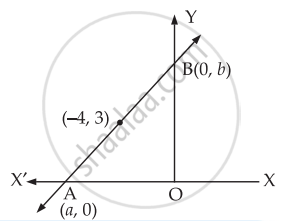Advertisements
Advertisements
प्रश्न
Find the equation of the line which passes through the point (– 4, 3) and the portion of the line intercepted between the axes is divided internally in the ratio 5 : 3 by this point.
उत्तर
Let AB be a line passing through a point (– 4, 3) and meets x-axis at A(a, 0) and y-axis at B(0, b).
∴ – 4 = `(5 xx 0 + 3a)/(5 + 3)`
⇒ – 4 = `(3a)/8` .....`[(because "X" = (m_1x_2 + m_2x_1)/(m_1 + m_2)),("and" "Y" = (m_1y_2 + m_2y_1)/(m_1 + m_2))]`
⇒ 3a = – 32
∴ a = `(-32)/3`
And 3 = `(5.b + 3.0)/(5 + 3)`
⇒ 3 = `(5.b)/8`
⇒ 5b = 24
⇒ b = `24/5`
Intercept form of the line is
`x/((-32)/3) + y/(24/5)` = 1
⇒ `(-3x)/32 + (5y)/24` = 1
⇒ – 9x + 20y = 96
⇒ 9x – 20y + 96 = 0
Hence, the required equation is 9x – 20y + 96 = 0.
APPEARS IN
संबंधित प्रश्न
The line through the points (h, 3) and (4, 1) intersects the line 7x – 9y – 19 = 0. at right angle. Find the value of h.
In the triangle ABC with vertices A (2, 3), B (4, –1) and C (1, 2), find the equation and length of altitude from the vertex A.
Find the equations of the lines, which cut-off intercepts on the axes whose sum and product are 1 and –6, respectively.
Show that the equation of the line passing through the origin and making an angle θ with the line `y = mx + c " is " y/c = (m+- tan theta)/(1 +- m tan theta)`.
Prove that the product of the lengths of the perpendiculars drawn from the points `(sqrt(a^2 - b^2), 0)` and `(-sqrta^2-b^2, 0)` to the line `x/a cos theta + y/b sin theta = 1` is `b^2`.
Find the equation of the right bisector of the line segment joining the points A (1, 0) and B (2, 3).
Find the equations of the sides of the triangles the coordinates of whose angular point is respectively (1, 4), (2, −3) and (−1, −2).
Find the equation of the side BC of the triangle ABC whose vertices are (−1, −2), (0, 1) and (2, 0) respectively. Also, find the equation of the median through (−1, −2).
Point R (h, k) divides a line segment between the axes in the ratio 1 : 2. Find the equation of the line.
Find the equation of a line for p = 8, α = 300°.
Find the equation of the straight line on which the length of the perpendicular from the origin is 2 and the perpendicular makes an angle α with x-axis such that sin α = \[\frac{1}{3}\].
Find the equation of a straight line on which the perpendicular from the origin makes an angle of 30° with x-axis and which forms a triangle of area \[50/\sqrt{3}\] with the axes.
Reduce the equation \[\sqrt{3}\] x + y + 2 = 0 to slope-intercept form and find slope and y-intercept;
Reduce the following equation to the normal form and find p and α in \[x + y + \sqrt{2} = 0\].
Reduce the following equation to the normal form and find p and α in y − 2 = 0.
Show that the origin is equidistant from the lines 4x + 3y + 10 = 0; 5x − 12y + 26 = 0 and 7x + 24y = 50.
Find the values of θ and p, if the equation x cos θ + y sin θ = p is the normal form of the line \[\sqrt{3}x + y + 2 = 0\].
Find the coordinates of the vertices of a triangle, the equations of whose sides are x + y − 4 = 0, 2x − y + 3 = 0 and x − 3y + 2 = 0.
Find the area of the triangle formed by the line x + y − 6 = 0, x − 3y − 2 = 0 and 5x − 3y + 2 = 0.
If the three lines ax + a2y + 1 = 0, bx + b2y + 1 = 0 and cx + c2y + 1 = 0 are concurrent, show that at least two of three constants a, b, c are equal.
Find the equation of the straight line perpendicular to 2x − 3y = 5 and cutting off an intercept 1 on the positive direction of the x-axis.
Find the coordinates of the foot of the perpendicular from the point (−1, 3) to the line 3x − 4y − 16 = 0.
Find the projection of the point (1, 0) on the line joining the points (−1, 2) and (5, 4).
Write the area of the figure formed by the lines a |x| + b |y| + c = 0.
The point which divides the join of (1, 2) and (3, 4) externally in the ratio 1 : 1
The figure formed by the lines ax ± by ± c = 0 is
Reduce the following equation into slope-intercept form and find their slopes and the y-intercepts.
x + 7y = 0
Reduce the following equation into intercept form and find their intercepts on the axes.
3x + 2y – 12 = 0
Reduce the following equation into normal form. Find their perpendicular distances from the origin and angle between perpendicular and the positive x-axis.
x − y = 4
